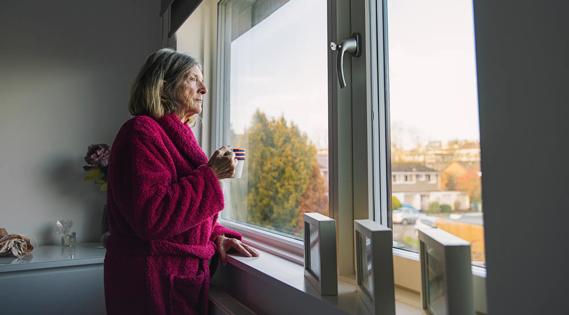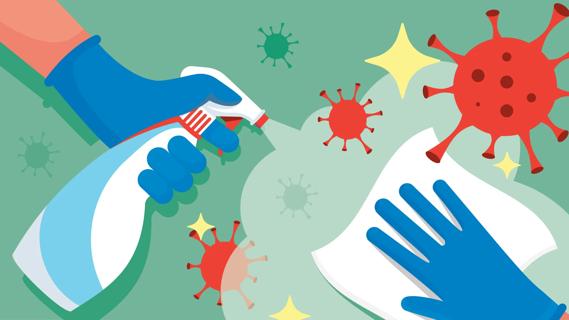Advertisement
A Cleveland Clinic expert explains the dangers of ignoring the pandemic

With the worst surge of coronavirus (COVID-19) cases yet continuing to grow at a rapid pace, the need for action to protect ourselves from contracting and spreading the virus has become a crucial part of our daily lives.
Advertisement
Cleveland Clinic is a non-profit academic medical center. Advertising on our site helps support our mission. We do not endorse non-Cleveland Clinic products or services. Policy
But there are still parts of the population that aren’t taking the threat as seriously as they should. Whether it’s denial, living in an echo chamber of disinformation or simply not being aware of the dangers, large swaths of people aren’t taking precautions to slow the spread.
According to infectious disease expert Carla McWilliams, MD, though, it’s essential that these people begin to treat the situation with the seriousness it deserves. So we talked to Dr. McWilliams about the current situation and why, exactly, it’s so important for everyone to do their part.
Perhaps the most important aspect of recognizing this latest surge, according to Dr. McWilliams, is how the lack of acknowledgment will cause cases to continue growing. “The general public needs to recognize and understand that the nationwide rates are dramatically rising and to not take it seriously is going to add fuel to that fire,” she says.
Dr. McWilliams also expresses concern that recent news about vaccine trials, while positive, may cause a false sense of security. “We as a population need to recognize that we’re still not at a point where we have a widely available, effective vaccine,” she notes.
“While the news is promising, those are still months away from being available to the general public,” she continues. “And while our treatment of those infected with the virus is better than when the pandemic started, none of those treatments guarantee that someone won’t suffer a serious illness or even die from the virus.”
Advertisement
Dr. McWilliams has helped treat hundreds of COVID-19 patients and continues to do so. And, in that time, she says, there’s a common theme she’s seen emerge from younger patients who believed they weren’t at risk. “They always end up in the hospital and they tell us, ‘I really didn’t think this would happen to me.’”
But by that point, she says, the damage is done. “You can’t turn back time to wear your mask properly and follow social distancing and wash your hands. You have to do it now.”
One of the things we’ve come to better understand during the pandemic is that there is a wide range of possible outcomes for patients who recover. While some never develop symptoms at all, those that do can experience anything from mild symptoms that they recover from to more severe cases that include severe side effects like lung damage, stroke or delirium.
And then there’s the issue of long-hauler patients for whom symptoms linger for weeks and months, never feeling fully recovered.
Dr. McWilliams has seen the struggles that come with having coronavirus, especially during the course of treatment. “Patients with COVID-19 who end up on ventilators for prolonged periods of time are debilitated afterward,” she says. “They’re very weak and require a long stay in the hospital for recovery and then face a tough rehabilitation ahead.”
Another concern, she says, are patients who still haven’t fully recovered. “Even after several months, they still haven’t fully recovered to their baseline,” she points out. “There’s underlying lung damage from COVID-19, from being on the ventilator and scarring of the lungs, too.”
Even when patients don’t go on ventilators, she says, they still have severe breathing issues. “I’ve seen patients who didn’t wind up on ventilators but they still required supplemental oxygen and we couldn’t get them off that oxygen for weeks. There’s still so much about this virus we don’t understand.”
As we’ve noted before, while the rate of recovery is certainly higher among younger patients, that doesn’t mean younger adults can’t develop severe cases of the virus or even die. “You’re at risk no matter the age,” says Dr. McWilliams.
“I’ve seen young men in their thirties with no underlying medical problems on ventilators having suffered strokes just like I’ve seen older patients with histories like high blood pressure not survive,” she adds. “To make an assumption that you’re immune or protected from the potentially terrible consequences of this virus just because you’re young is a foolish assumption.”
Advertisement
There are many cases where a patient’s symptoms are very mild or non-existent. But that doesn’t mean asymptomatic cases aren’t a risk. Again, it’s an aspect of the pandemic that’s been pointed out multiple times but still doesn’t seem to be sinking in with everyone: asymptomatic cases can still spread the virus.
“It’s possible you could have the mildest or no symptoms and think nothing of it,” Dr. McWilliams says. “But the problem is, from a public health standpoint, that individual is still actively infectious. That individual is capable of coming home and giving the illness to their parents, their grandparents and even their children.”
This ability to spread the disease is why the CDC has advised against family gatherings during the holiday season, especially since those gatherings can often become superspreader events.
There’s another battle being fought in addition to the virus, though, and that’s misinformation and it has taken a few different forms.
Those who don’t believe masks work point to rising cases in spite of mask mandates all over the country as proof. The rising cases, though, aren’t because masks don’t work. Rather, it’s because not enough people are wearing them.
“That approach is very unfortunate,” Dr. McWilliams adds, “because we have enough evidence that tells us that universal masking works. We really need the public to follow that evidence, that it’s effective. We can really only do the help and buy-in of the community-at-large.”
Advertisement
There’s also the issue of wearing your mask correctly. Wearing it incorrectly can both leave you more vulnerable and make it easier for you to spread the virus if you have it.
“You have to wear the right mask and wear it the right way,” Dr. McWilliams says. “It has to cover your mouth, it has to cover your nose and you can’t keep taking it off and putting it back on. That defeats the purpose.”
The intention of the mask is two-fold, she says. The first is to control and contain the spread of your own respiratory droplets. If you’re asymptomatic or still in the pre-symptom stage of the virus, the correctly worn mask will keep your virus-laden droplets from reaching others.
Second, she says, is to keep you from touching your face – especially your nose and mouth – with your hands. Otherwise, you could either contract the virus or spread it via that fingertip-to-face connection.
“This is the most important aspect of preventing the spread of this pandemic,” she adds. “Masks work but they have to be worn correctly for them to have the effect we need them to.”
Another piece of misinformation people tend to share or believe about the surges of positive COVID-19 cases is that it’s only a reflection of more testing. But that ignores a key component of the pandemic: the positivity rate of a community.
Advertisement
The positivity rate tells you what percentage of a community has tested positive for the virus and as cases have skyrocketed during this wave, both total cases and positivity rates have increased dramatically.
“To say that cases are going up because there’s more testing is short-sighted,” Dr. McWilliams says. “When the positivity rate goes up in your community, that means there are more individuals spreading the disease. And if you look at the sheer number of hospitalizations, you can clearly see that this not just about having more tests. There are clearly more very sick people in the country right now.”
Learn more about our editorial process.
Advertisement

Studies have shown promising results, but additional research is needed

Infection and inflammation can cause you to lose your voice and have other voice changes until you’re fully healed

A COVID-19 infection can bring on depression or anxiety months after physical symptoms go away

Just like the flu, COVID-19 continues to evolve every year with new and smarter variants

The latest omicron subvariants carry specific mutations that may allow the SARS-CoV-2 virus to be better at evading immune protection

You can work out with mild COVID-19, but not in a gym, and listen to your body and don’t overdo it

Most people can return to work and regular life when they’re symptom-free for 24 hours

Lysol Disinfecting Wipes are just one of more than 500 products approved by the EPA for protection against the SARS-CoV-2 virus that causes COVID-19

If you’re feeling short of breath, sleep can be tough — propping yourself up or sleeping on your side may help

If you fear the unknown or find yourself needing reassurance often, you may identify with this attachment style

If you’re looking to boost your gut health, it’s better to get fiber from whole foods